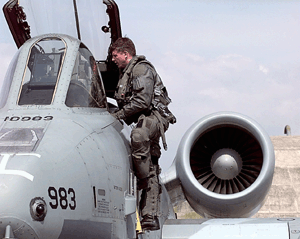Combat Proven
Maintenance

TF-34 engines are essentially two level maintenance via user Queen Bee sites at Barksdale, Davis-Monthan and Shaw AFBs. All ACC aircraft TF-34 engines are repaired at Davis-Monthan or Shaw AFB. Shaw AFB also supports USAFE. PACAF uses a combination of two and three level maintenance; Osan AB utilises regional support provided at Kadena AB, while Eielson AFB performs Jet Engine Intermediate Maintenance (JEIM) on-sight. Barksdale AFB regionally supports AFRC. The ANG remains entirely supported by base field JEIM shops. Depot level engine maintenance is accomplished by the Navy at Jacksonville NAS, FL. The A/OA-10 has 51 avionics line replaceable units that transition to two level maintenance.
The A/OA-10 was designed for user maintenance in all normal maintenance inspections and tasks. This design has been very successful for this aspect and there is every expectation this will continue for the life of the weapon system. The only depot level requirements are Analytical Condition Inspection (ACI) and unscheduled depot level repair, otherwise the A-10 should have a useful life of 8,000 hours.
ACI is a specialised inspection to check areas, sub-systems or parts that are not checked on any periodic basis during normal maintenance. The purpose of the ACI is to find developing problems that might affect the mission or ensure such conditions do not exist. Problems discovered during ACI result in engineering studies that determine appropriate corrective action. There are 11 ACI aircraft selected (by usage, age, flight hours and environment) from different bases and MAJCOMs that are scheduled per fiscal year. The ACIs are accomplished at OO-ALC.
Unscheduled depot repair occurs when an aircraft incident, accident or other unusual occurrence creates a problem beyond the users ability to correct. Such occurrences result in a request from the MAJCOM for depot assistance. Depending on the situation, the aircraft may be inducted into a depot or contractor facility, or a depot or contractor field team may be dispatched to the location of the aircraft.
The A/OA-10 has a requirement for repaint every eight years. The fleet size sets the current requirement to approximately 65 per fiscal year. While this is not strictly a depot requirement, the need for a fixed, specialized and environmentally contained facility limits the user in his choices. The A/OA-10 is primarily painted at OO-ALC; however, Daimler-Benz AG in Germany paints USAFE aircraft. For economic reasons the 11 ACI aircraft inducted into OO-ALC each year are also painted.